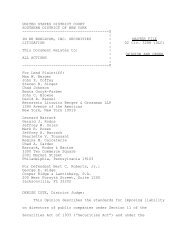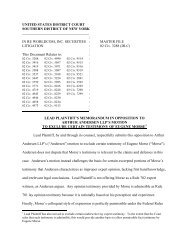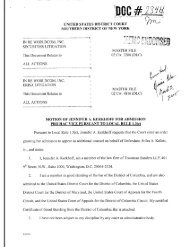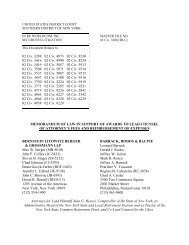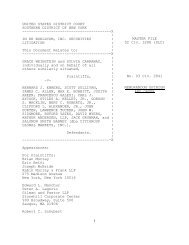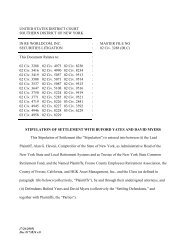Lead Plaintiff's Memorandum of Law in Opposition to Defendants'
Lead Plaintiff's Memorandum of Law in Opposition to Defendants'
Lead Plaintiff's Memorandum of Law in Opposition to Defendants'
Create successful ePaper yourself
Turn your PDF publications into a flip-book with our unique Google optimized e-Paper software.
The Underwriter Defendants assert that the Court must now dismiss the Section 11 and Section<br />
12(a)(2) claims aga<strong>in</strong>st them from this consolidated action on the ground that the party appo<strong>in</strong>ted by the<br />
Court as <strong>Lead</strong> Pla<strong>in</strong>tiff, the NYSCRF, did not purchase the debt securities issued on those Offer<strong>in</strong>gs,<br />
even though Named Pla<strong>in</strong>tiffs Fresno, FCERA and HGK did. Defendants’ argument -- never<br />
accepted by any court -- is unavail<strong>in</strong>g.<br />
Accord<strong>in</strong>g <strong>to</strong> the Underwriter Defendants, under the PSLRA, a lead pla<strong>in</strong>tiff’s consolidated<br />
plead<strong>in</strong>g may assert only those claims that the lead pla<strong>in</strong>tiff personally possesses, notwithstand<strong>in</strong>g the<br />
fact that there are other pla<strong>in</strong>tiffs specifically named <strong>in</strong> the consolidated compla<strong>in</strong>t who do have stand<strong>in</strong>g<br />
<strong>to</strong> assert those claims. In other words, these Defendants argue that the PSLRA swept aside the notion<br />
<strong>of</strong> class representatives or named pla<strong>in</strong>tiffs for securities class actions -- that Congress actually <strong>in</strong>tended<br />
that, if the lead pla<strong>in</strong>tiff did not possess every claim that the class had, those claims would either have <strong>to</strong><br />
be (a) asserted <strong>in</strong> a second, or perhaps third or fourth separate class action, all <strong>of</strong> which relate <strong>to</strong> the<br />
same fraud but nevertheless required a different lead pla<strong>in</strong>tiff, or (b) prosecuted <strong>in</strong> one action with a<br />
multi-headed leadership structure that had as many lead pla<strong>in</strong>tiffs as there were potential claims.<br />
Neither can be reconciled with pr<strong>in</strong>ciples <strong>of</strong> judicial economy or, more on po<strong>in</strong>t, the PSLRA that<br />
governs this very question. See Aronson v. McKesson HBOC, Inc., 79 F. Supp. 2d 1146, 1151<br />
(N.D. Cal. 1999) (“one lead pla<strong>in</strong>tiff can vigorously pursue all available causes <strong>of</strong> action aga<strong>in</strong>st all<br />
possible defendants under all available legal theories”). Perhaps not surpris<strong>in</strong>gly, this argument has<br />
never been accepted by any other court and was, <strong>in</strong> fact, decisively rejected only a few weeks ago <strong>in</strong><br />
this District by Judge Sche<strong>in</strong>dl<strong>in</strong> <strong>in</strong> IPO Sec. Litig.<br />
In that case, defendants raised the same issue, argu<strong>in</strong>g that, if a lead pla<strong>in</strong>tiff were unable <strong>to</strong><br />
assert a particular claim itself, then it could not assert that claim <strong>in</strong> a consolidated securities class action<br />
-30-



